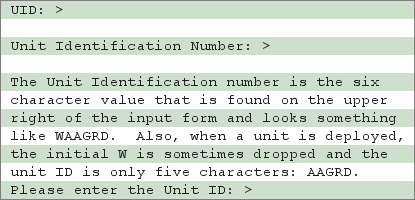Three Levels of Prompts
In 1980, while in the Army, I found myself writing a program to handle administrative details of security clearances. I had to define a human interface for a typewriter interface as monitors were not common. While working with this interface I codified the first of my Rules of Three. When a typewriter is the operator interface, the operator has to wait for each letter to type. So when prompting for information, if you had a long explanation, the operator was forced to wait while a long time while the prompt typed. By using and watching others use the interface, I discovered, very quickly, the operator learned the patterns and needed very little information in the prompt. So I developed a three tiered prompt system.
 In the example on the right, the three levels of prompt are shown.
In the example on the right, the three levels of prompt are shown.
The first prompt was a single word or abbreviation, in this case: UID
If the operator pressed enter without entering a valid response, the system would give a slightly longer response. In the example abbreviation, UID, is expanded: Unit Identification Number
If that still didn’t explain enough then the system would give a full explanation. In this example, the what the UID is explained.
Curiously, people communicate the same way. This idea is expanded in the following pages:
Three Types of Student and The Word, Phrase, & Paragraph.